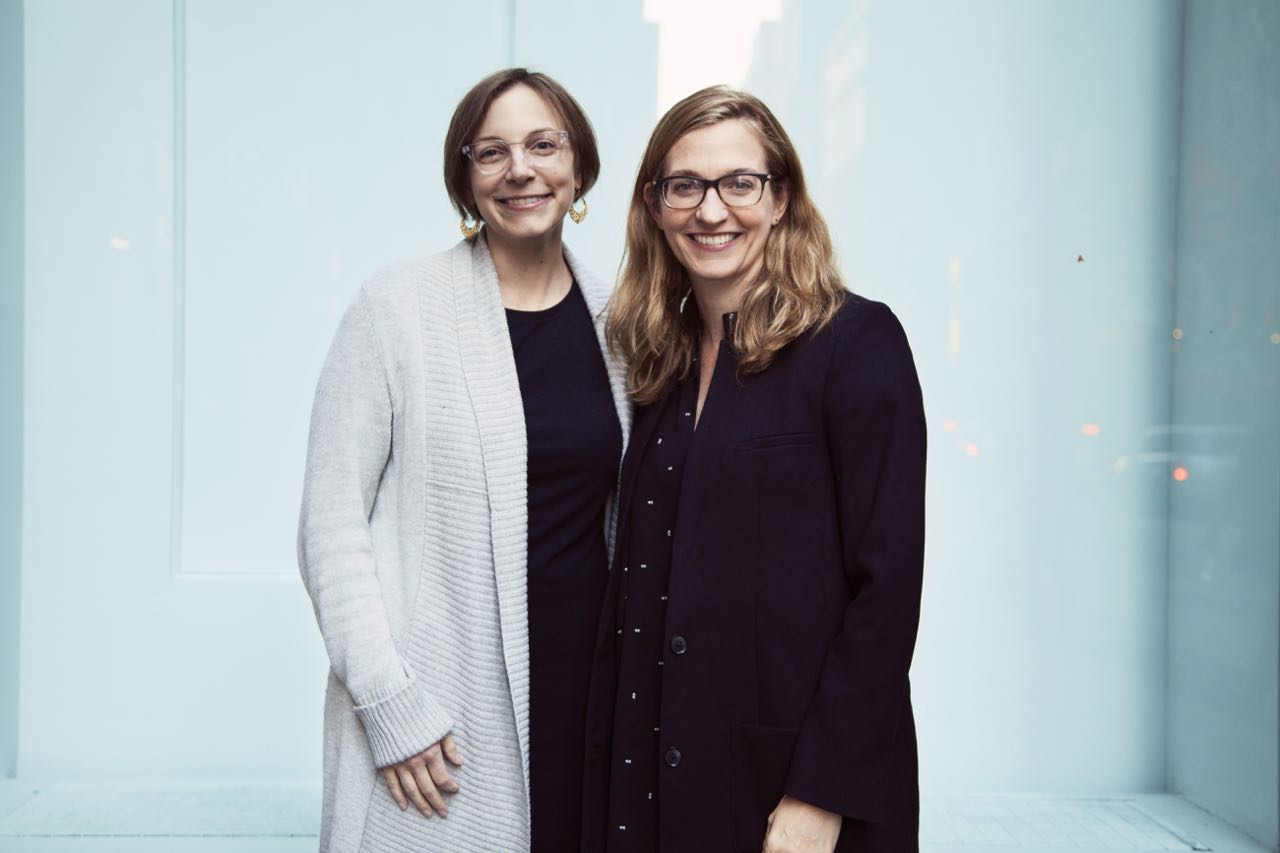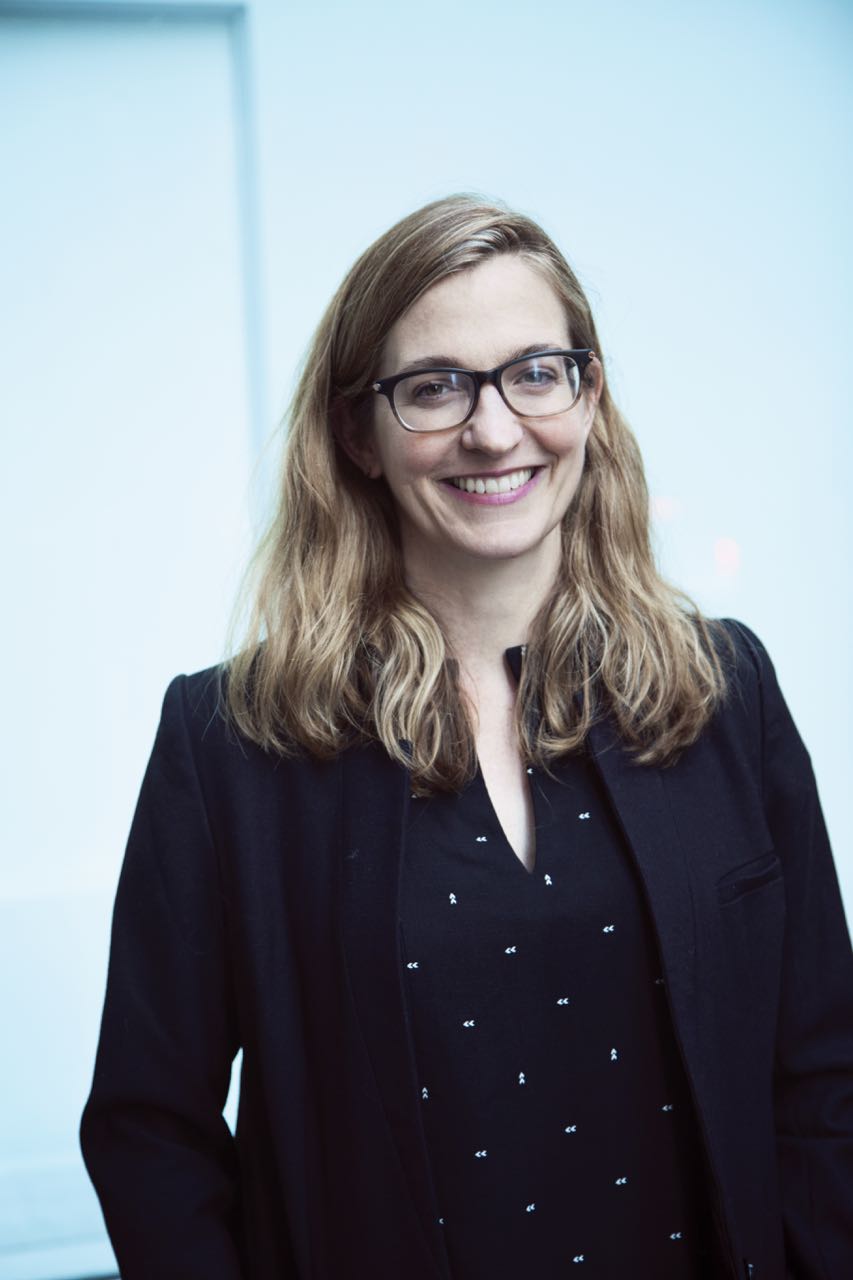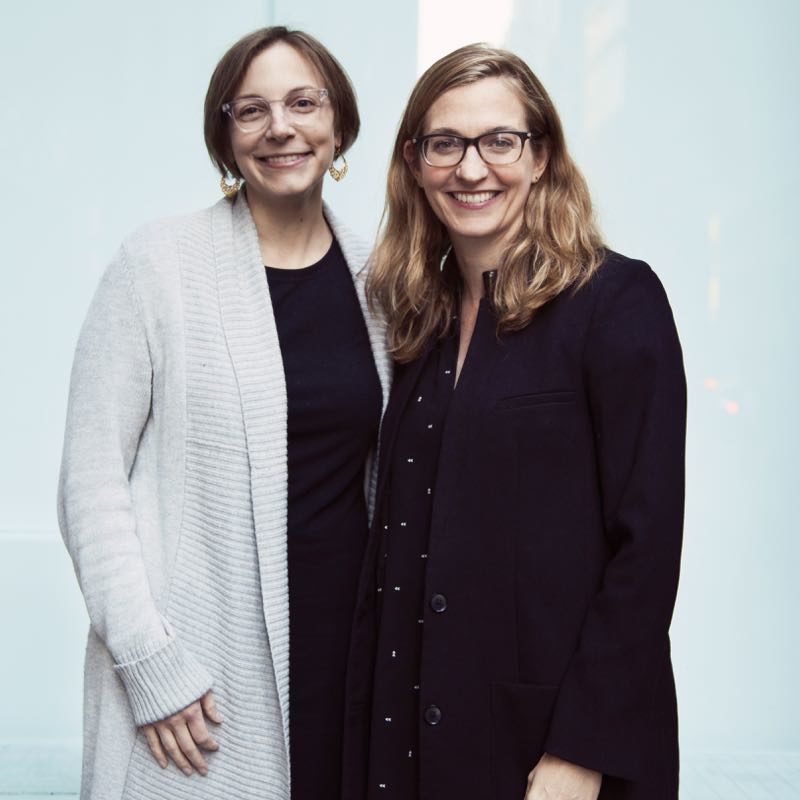Gaye Taylor Upchurch and Anna Ziegler on “The Last Match”

Written by Victoria Myers
Photography by Sofia Colvin
October 18th, 2017
In Anna Ziegler’s newest play, The Last Match, directed by Gaye Taylor Upchurch and currently playing at the Roundabout, an aging (by sports standards) tennis star faces off in a match at the U.S. Open against a young rival. The tennis backdrop serves as the setting to bounce off themes of ambition, change, and doing what you love. It also offers some unique theatrical challenges: how do you put sports on stage? How do you put sports on stage in a play that also utilizes direct address? Anna and Gaye Taylor have been working on the play since the summer of 2015, and the Roundabout production marks the play’s New York premiere. We recently sat down with them to discuss their process and the themes of The Last Match.
You’re in previews now and still rehearsing. What was your day like?
Gaye Taylor: Today was an exciting day. We have a few rehearsals left but Anna’s hit on a new ending for the play.
Anna: No pun on hit.
Gaye Taylor: We started off reading six new pages for the ending of the play and had a group discussion with the actors about that. Anna then took that information away and reworked it while we re-teched a few things on stage, made some other changes. Then, at the end of the day, Anna came back with another new version of the six pages, which we’ll now put in tomorrow. We used part of our day to find a really exiting new ending.
Anna: Yeah, it was a very productive day. It was packed.
Gaye Taylor: Sometimes when you’re in the tech process, the show is a little bit tech heavy. That can take over and you don’t get as much time as you want to, to get to rehearse with the actors. We got to do that today as well, which was great.
Did you two know each other before working on this show?
Gaye Taylor: Yes. We met through some mutual friends, socially. This is our first play to work on together.
Anna: We’ve worked on it for a while together.
When you first started working on it, what was your jumping in point as a director?
Gaye Taylor: From the beginning, this play to me seemed to have a huge physical component. The first thing that we did together was that we got to work on it at New York Stage and Film. They talked to us early on about whether there was a designer that we wanted to bring into the process. We already were toying with this idea of, “What happens if we have the physicality of tennis without the paraphernalia of tennis?” If we have a really kick ass sound design to support the tennis match [that could work]. We asked [sound designer] Bray Poor to come up with us to New York Stage and Film, which he did. At the very beginning of our work together, we were already starting to understand the physical version of the play, which for me was really fun as a director to get to dive into that early on.
Anna, for you, what was your jumping off point for writing the play?
Anna: There were a few, as there almost always are. I had been wanting to write a play about tennis, or using tennis for backdrop, for a while. I played tennis as a kid. I’m a big tennis fan. I think there’s something unique and richly metaphorical about tennis, even more than other sports in some ways. When I was about to have my first child, Andy Roddick retired. The speech that he gave on court at the U.S. Open, I found very powerful and moving. At that point, the play sort of started to take shape for me because here was this person who was about my age, who was putting his whole life behind him, his identity was about to shift. I think something about that in connection to me also facing a shift in my life kind of got the seed for the play growing.
Let’s talk more about the development process. How helpful was it for this play to have actors up on their feet and have the world physicalized?
Gaye Taylor: I was excited by the challenge of putting a tennis match on stage and bringing the U.S. Open into the theatre—what that might sound or look like. My background is in dance. Any show that I’m directing, I think I’m very drawn to bodies and space and the story that we’re telling from a physical standpoint, as well as with text. At the very beginning, we went through the script to find where the places are that we can draw out to physicalize it. Because that wasn’t written into the script, but it definitely allows for that. Anna’s language is very poetic, which I think lends itself to a bigger physical gesture than it might if it were very pedestrian language. It’s very heightened in certain places. Then we also found, “What if we had tennis here? What does that do to the rhythm?” Anna could speak to that—”That works,” or, “That slows it down too much.” We could work together to find where the tennis moments could happen. Then, yet another part of the process was once the actors were on board, because they have instincts too about where a hit might belong, which is really helpful. I think it was a very collaborative process that started with my going through the script to find places were I thought we could physicalize what the text was. Also, for the story of it, to say, “Here’s a big point that’s being played. Here’s a big moment that we might want to show what’s happening here along side the narration of it.” The play goes back and forth between narration and scene work. There’s a lot of direct address to the audience. That’s been fun to play with where can we physicalize that so that it’s narration, but also so the actors get to drop into the actual moment of the tennis as well.
Anna: I think it helps as you think about the rhythm of the play, to get the sense of other ways it could be activated. As GT said, there’s some poetic monologues to this play. There’s a sense that those can exist in an activated way or those are going to be quiet and there’s going to be action all around them. You start to have a sense of power that the play lives in space, really early on, and what it can hold.

We talked about this when we were talking about Actually, but did you find for this play that form dictated content or content dictated form?
Anna: I think content dictated form. Tennis certainly came first, and the idea that we were going to weave in and out of the match and see other parts of these guys’ lives. It was certainly the content of a tennis match that supplied the form. It was great to be able to borrow from the structure of a match that way. It allows you to really play inside of it.
As you were developing the play, and particularly in this process, have you found what themes are jumping out at you? Has that changed over time? Are there certain things that you want to emphasize more now than you did at the very beginning?
Gaye Taylor: As Anna said, she started thinking about [the idea for the play] before giving birth to her son. For the first production of this play, I was not a parent. I had twins fairly soon before we started rehearsals for this play. I do think the themes of a big shift in your life and accepting change in your life, coming up against the limits of yourself and your mortality, those themes that run through the play as filtered through being a new parent ran much deeper for me this time around.
Anna: And I had another kid in the interim. I feel even closer to death.
Gaye Taylor: Yeah, the passage of time.
Anna: I think it was coming to understand more the struggle of the main character in this production. There’s a way in which it’s in part, “Do not go gentle into that good night.” Fighting against getting older and the idea that his body might fail him and he won’t be able to do this anymore. At the same time, I hope, embracing the side of him that just loves tennis. There are these other themes in the play, but a big part of it is his love of the game and how it’s incredibly hard to leave something behind that you love.
Gaye Taylor: Ambition versus limitation versus acceptance.
For this particular production at the Roundabout, how have you found being in front of an audience has affected the process?
Gaye Taylor: One thing that’s different is that in our first production of this play it was in the round. This is a huge change. The design changed entirely and approach to staging and how we’ve been working on the piece itself. Also, we have a much longer preview process here. In San Diego, we had four or five previews, which is basically enough time to tech it, get it up, and run it a few times, and then you’re gone. For this process, we’ve had a healthy amount of previews. Anna’s really gotten to make more changes and hear the play several times in front of an audience and really analyze what we’re learning from the audience.
Anna: It extends the torture. It brings to mind that saying that people often talk about in connection to wedding planning that, “However much time you allow, you will find a way to fill it.” People say, “Should I plan my wedding for a year and a half or should I plan it in three months?” Either way, you are going to have that wedding. I feel like it’s wonderful to have all these previews and it also kind of taunts you. You know that you still do have some time to make changes. If you’re a perfectionist, and I think most of us are who are doing this want it to be the best it can be, you’re always looking for things that you can refine up until the last minute.
Gaye Taylor: Yes, it extends the torture, but also there are certain things that I think you don’t learn until you live with it for a while.
Anna: That’s true.
Gaye Taylor: After truly extending the torture, Anna came in with a new ending that I think is smart.
When you have been working on a play for a while, what’s the process like for deciding something needs to change completely versus something that maybe just needs to be tweaked? How do you make those choices?
Gaye Taylor: It’s a combination of things. We both take our own notes during the show. That will lead to a discussion of some kind, either before rehearsals or on a day when there’s two shows where Anna and I can have a little bit more time to talk because we don’t have rehearsal on those days. We’re working within the confines of how much time we actually have on stage and what’s doable that day. Sometimes we have notes and ideas and changes that we want to make but we don’t get to make that day. We kind of punt those to the next day or the day after. I think at the beginning, we were trying to make sweeping changes. If we had bigger changes to make, we were trying to do those right at the beginning so we could re-tech them and live with them for a little while. If we needed to change anything back, we could. We made a couple of big changes right at the top. It takes you a few rehearsal days to work through that and see it land in front of multiple audiences. Then the smaller tweaks start to happen. I think that’s kind of how we’ve been working. It was like broader strips at the beginning, and then we get in and make the smaller tweaks. Then, we have this one big project we just did that I think is smart and that we couldn’t have gotten to it until we had made those other changes.
Anna: You can’t really predict when you’re going to have a breakthrough, which is too bad, because obviously it would be easier if your play was perfect from the start and actors didn’t have to relearn new lines and things like that. I think there is something about the window of time for making changes closing that makes you listen very closely to your play and think about, “What can I do in the final days of the rehearsal?”

I hate this question, but I’m going to ask it anyway. In the past, have you had anyone make any comments or strange remarks about, “Oh, women doing a play set in the sports world”?
Gaye Taylor: Actually, no. I’m saying that with sort of a surprise because it is surprising that nobody has said anything like that, but not at all, which is great. Refreshing.
Anna: No, I haven’t had. Certainly not to my face.
Since you both have children—and something that comes up time and time again is balancing childcare with working—how has that been going?
Gaye Taylor: I’m really new at it. My kids are three months old. Because I’m so new at it, I’ve actually had temporary measures in place that are going away. My mother was here for a very long time, which was very helpful. I had other family members come in and help. The Roundabout let me turn a room into a nursery during our tech schedule, which was amazing. The twins were actually here in the building with me, which cut down a lot on childcare time. It’s something that I’m looking to in the future and I can see that it’s an issue, for sure.
Anna: It’s hard. I think you sort of cobble things together. I would say, even though I tend to have enough coverage between a babysitter and my mother and my husband, when we’re in an intense process like this and we’re here often all day and into the night, it’s almost less about the coverage than just about not being there for your kids. You’re feeling like there are many days in a row where you’re barely seeing them. You have to balance the guilt of that with what you feel you need to do for yourself. I think one hopes that ultimately, one’s children will benefit from the fact that their mother sometimes went away and worked hard.
Gaye Taylor: You’re fulfilled in some way that’s helpful to the entire relationship. My husband got extended paternity leave, which helped me very much to be able to do this. I think it’ll also be a back and forth between the two of us, figuring this out as we move forward.
What kind of systemic changes in the theatre community do you think would be most helpful in terms of making it easier for parents to work and do their job?
Gaye Taylor: I hope that’s a question that’s being asked all over the place. I will say that Roundabout worked with me in such a great way. They set up a pump room for me and let me set up this nursery here. All of which was really helpful and helped me to be able to see them more and feel like I was still taking care of them in some way when I was away from home. Having kids be able to be around I think is hugely helpful. Even if someone else is looking after them, if they can be in the theatre or nearby somewhere, that was huge for me. I think that could be really beneficial.
What do you hope audiences take away from the show?
Anna: I hope that it was a full night at the theatre. That ultimately it was a heartwarming story and funny. I hope it was kind of unique theatrical storytelling.
Gaye Taylor: I hope they’re entertained. I think there’s something very entertaining about this play that Anna’s written. It’s very different in its structure, which I hope helps people navigate the themes in the play. There’s something very meditative about this work for me, too. Hopefully it invites reflection, which I think is a thing that the theatre does really well;—gather people and say, “Let’s all turn our attention to this one particular aspect of being a human being and just take a moment to look at it.” I think this play does that really well. A lot of it is direct address and internal monologue, so we actually get a real glimpse into what’s going on in their heads. I think it puts that in the air in theatre in a really great way: the reflection and meditation on what it means to be here and try to be fulfilled in your one life.
[Editor’s Note: Disclosure, I’m a member of the Ambassador’s Council of GenR at the Roundabout]

